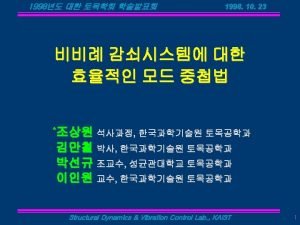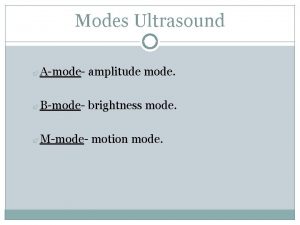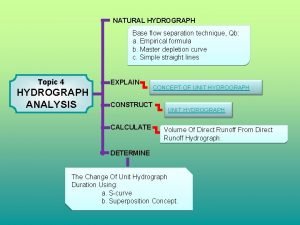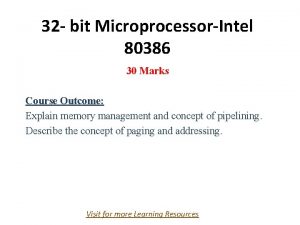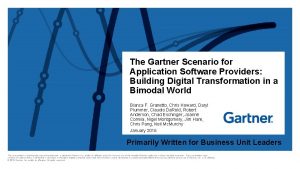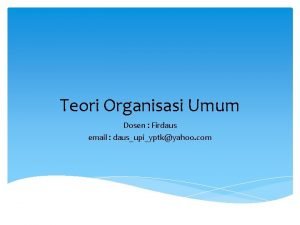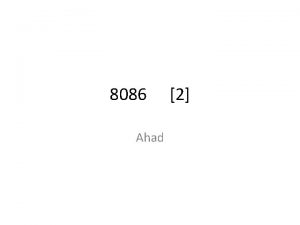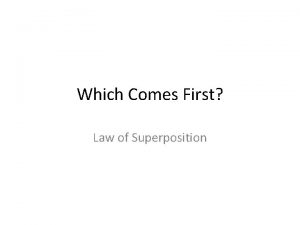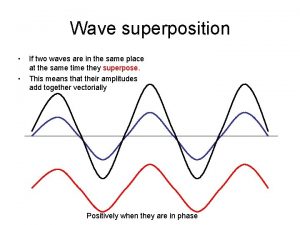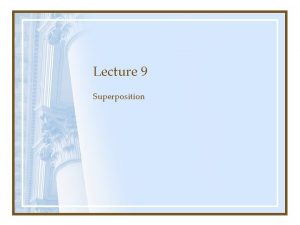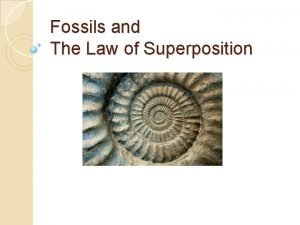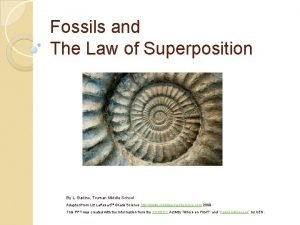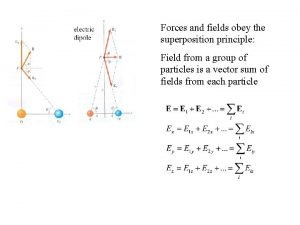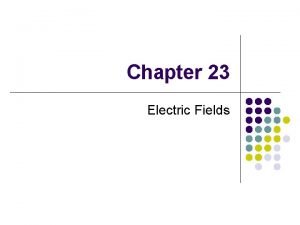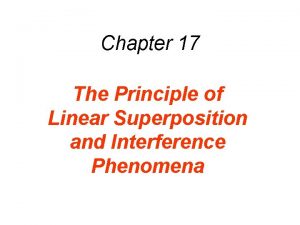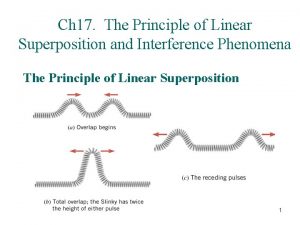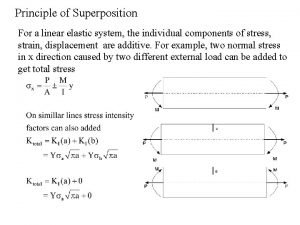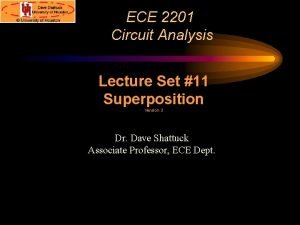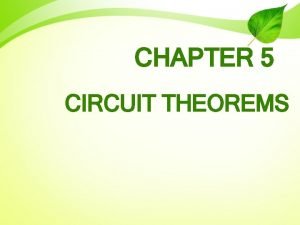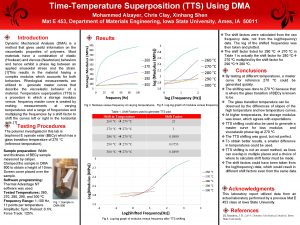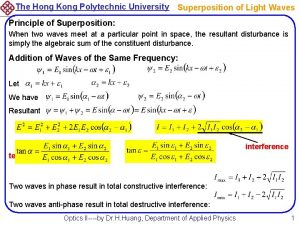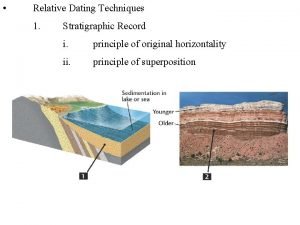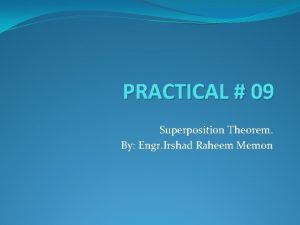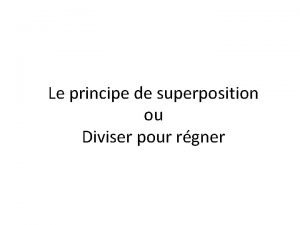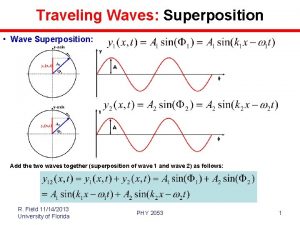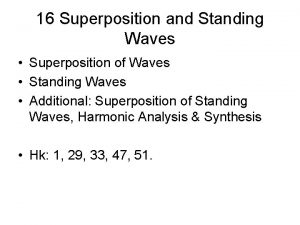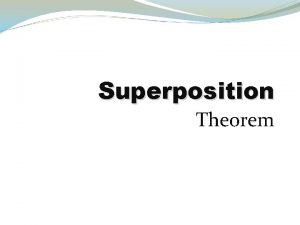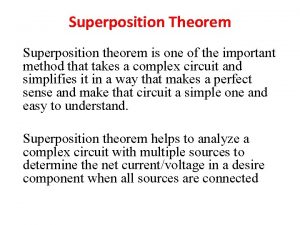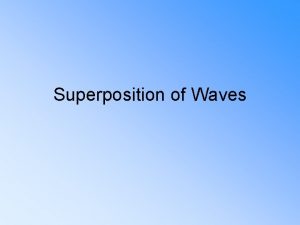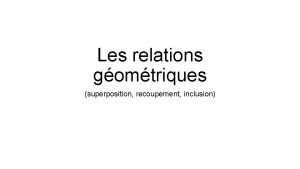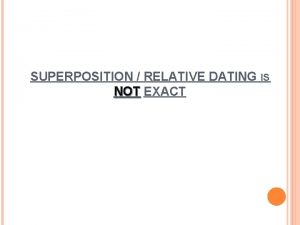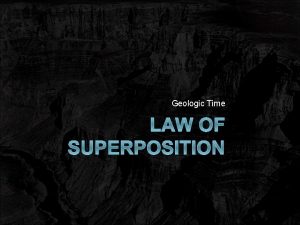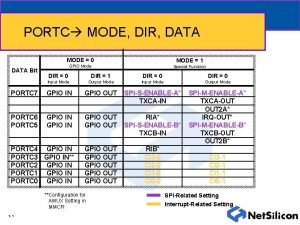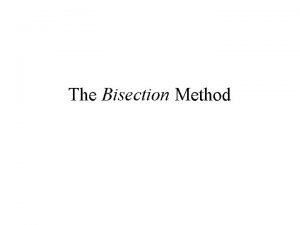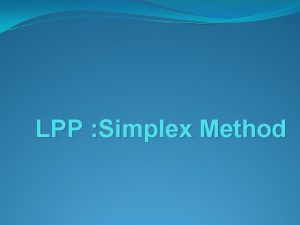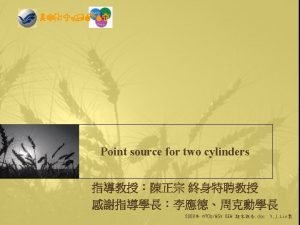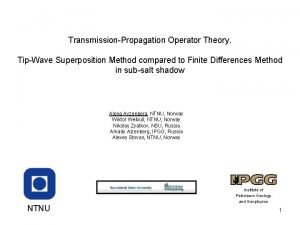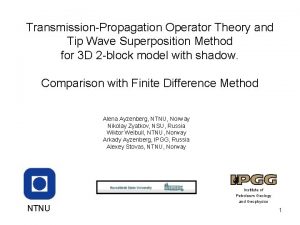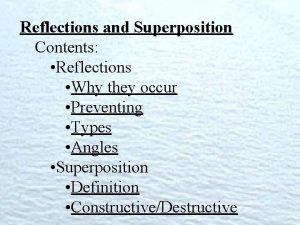CONTENTS l Introduction l Mode Superposition Method for




























- Slides: 28


CONTENTS l Introduction l Mode Superposition Method for Classically Damped Systems l Mode Superposition Method for Non-Classically Damped Systems l Numerical Examples l Conclusions Structural Dynamics & Vibration Control Lab. , KAIST 2

INTRODUCTION Background l Dynamic Equations of Motion (1) where M C K u(t) f(t) : : : Mass matrix of order n Damping matrix of order n Stiffness matrix of order n Displacement vector Load vector l Methods of Dynamic Analysis w Direct integration method w Mode superposition method Structural Dynamics & Vibration Control Lab. , KAIST 3

l Advantages of Mode Superposition Method w Effective because of using a few modes w Gives the dynamic characteristics of each mode w Effective for long duration loading l Drawbacks of Mode Superposition Method w Fail to give an accurate solution w Need to consider the effects of truncated high modes l Improved Mode Superposition Methods w Mode acceleration method (MA method) w Modal truncation augmentation method (MT method) Structural Dynamics & Vibration Control Lab. , KAIST 4

Non-classically Damped System l Decoupling the System (1) (2) where l If Cg has off-diagonal elements, C is called as non-classical damping approximate to classically damped system so, off-diagonal terms are ignored Structural Dynamics & Vibration Control Lab. , KAIST 5

Objective In this study, improved mode superposition methods are applied to non-classically damped system Structural Dynamics & Vibration Control Lab. , KAIST 6

MODE SUPERPOSISTION METHOD FOR CLASSICALLY DAMPED SYSTEM Mode Superposition Method l The Dynamic Equations of Motion (1) l Decoupled Equations by Eigenvectors (2) l Displacements us(t) (3) where Structural Dynamics & Vibration Control Lab. , KAIST 7

Mode Acceleration Method (MA Method) l The Solution by MA Method (4) (5) (6) where us(t) : displacements modally represented ut(t) : displacements not represented by the modes r(t) : time varying portion of f(t) R 0 : invariant spatial portion of f(t) Structural Dynamics & Vibration Control Lab. , KAIST 8

l The Portion of MA Solution w us(t) : displacements modally represented (7) w ut(t) : displacements not represented by the modes (8) where : force truncation vector : modally represented spatial load vector MA method approximates ut(t) by a static solution Structural Dynamics & Vibration Control Lab. , KAIST 9

Modal Truncation Augmentation Method (MT Method) l The Solution by MT Method (4) l The Portion of Solution w us(t) : displacements modally represented (7) w ut(t) : displacements not represented by the modes (9) MT method approximates ut(t) by a dynamic solution Structural Dynamics & Vibration Control Lab. , KAIST 10

l Derivation of Pseudo Eigenvector P (10) where Structural Dynamics & Vibration Control Lab. , KAIST 11

MODE SUPERPOSISTION METHOD FOR NON-CLASSICALLY DAMPED SYSTEM State Space Equations l State Space Equations (11) where Structural Dynamics & Vibration Control Lab. , KAIST 12

l Associated Eigenvalue Problem (12) l Eigenvalue and Eignevector (13) where Structural Dynamics & Vibration Control Lab. , KAIST 13

l Mode Superposition Method in Non-Classically Damped System w State space equation (11) w Decouple the eqn. (3) by complex eigenvector (14) w Displacements ys(t) (15) Eigenvectors are conjugate pairs (16) Structural Dynamics & Vibration Control Lab. , KAIST 14

MA Method l The Solution by MA Method (17) (18) where ys(t) : displacements modally represented yt(t) : displacements not represented by the modes r(t) : time varying portion of F(t) R 0 : invariant spatial portion of F(t) Structural Dynamics & Vibration Control Lab. , KAIST 15

l The Portion of Solution w ys(t) : displacements modally represented (19) w yt(t) : displacements not represented by the modes (20) where : force truncation vector : modally represented spatial load vector y(t) is calculated from conjugate pair MA method approximates yt(t) by a static solution Structural Dynamics & Vibration Control Lab. , KAIST 16

MT Method l The Solution by MT Method (17) l The Portion of Solution w ys(t) : displacements modally represented (19) w yt(t) : displacements not represented by the modes (21) MT method approximates yt(t) by a dynamic solution Structural Dynamics & Vibration Control Lab. , KAIST 17

l Derivation of Pseudo Eigenvector P (22) where Structural Dynamics & Vibration Control Lab. , KAIST 18

NUMERICAL EXAMPLES l Structures w Four-story shear building w Cantilever beam with multi-lumped dampers l Comparisons w Displacement responses w Displacement error of each method Structural Dynamics & Vibration Control Lab. , KAIST 19

Four-Story Shear Building R 0 cos t M 1 K 2 K 3 K 4 M 2 M 3 M 4 U 1 U 2 U 3 • Input load ( R 0 cos. Wt ) R 0=1 W = 7 rad/sec (≒ 0. 5 w 1 ) w 1 = - 0. 0317 ± 13. 2935 i w 2 = - 0. 0007 ± 29. 6597 i U 4 Structural Dynamics & Vibration Control Lab. , KAIST 20

Displacement Responses (using 1 mode) Time(sec) Structural Dynamics & Vibration Control Lab. , KAIST 21

Displacement Responses(using 2 modes) Time(sec) Structural Dynamics & Vibration Control Lab. , KAIST 22

Displacement Error Using 2 Modes Difference Using 1 Mode Time(sec) Structural Dynamics & Vibration Control Lab. , KAIST 23

Cantilever beam with multi-lumped dampers R 0 sin(W t) 1 2 3 45 14 • Material property Tangential damper, c : 0. 3 Young’s modulus : 100 Mass density : 1 Moment of inertia : 1 Cross-section area : 1 • Input 49 50 load ( R 0 cos. Wt ) R 0=1 W = 5 rad/sec (≒ 0. 6 w 1 ) w 1 = -0. 2696877077± 7. 7304416035 i w 2 = -0. 4278691331± 9. 7835115896 i Structural Dynamics & Vibration Control Lab. , KAIST 24

Displacement Responses (using 1 mode) Time(sec) Structural Dynamics & Vibration Control Lab. , KAIST 25

Displacement Responses (using 2 modes) Time(sec) Structural Dynamics & Vibration Control Lab. , KAIST 26

Displacement Error Using 1 Mode Time(sec) Using 2 Modes Time(sec) Structural Dynamics & Vibration Control Lab. , KAIST 27

CONCLUSIONS u Improved mode superposition methods are applied to non-classically damped systems. u MA method and MT method are more efficient than simple mode superposition method. u MA method and MT method have same convergence rate in non-classically damped system. Structural Dynamics & Vibration Control Lab. , KAIST 28
 Mode superposition method
Mode superposition method A mode ultrasound
A mode ultrasound Unit hydrograph superposition method
Unit hydrograph superposition method Focus mode and diffuse mode
Focus mode and diffuse mode Mode địa chỉ tức thì là mode
Mode địa chỉ tức thì là mode Difference between real mode and virtual mode of 80386
Difference between real mode and virtual mode of 80386 Timer in microcontroller
Timer in microcontroller Gartner mode 1 mode 2
Gartner mode 1 mode 2 Perbedaan (planning mode) dan (evolutionary mode)
Perbedaan (planning mode) dan (evolutionary mode) 8088 data bus
8088 data bus Contents introduction
Contents introduction Law of superposition examples
Law of superposition examples Superposition of waves
Superposition of waves Superposition theorem
Superposition theorem Superposition fossils
Superposition fossils Law of superposition fossils
Law of superposition fossils Superposition principle
Superposition principle Superposition principle electric field
Superposition principle electric field Linear superposition
Linear superposition The principle of linear superposition
The principle of linear superposition Principle of superposition in stress and strain
Principle of superposition in stress and strain Ece 2201
Ece 2201 Source conversion
Source conversion Dma tts
Dma tts Superposition of light
Superposition of light Principles of stratigraphy
Principles of stratigraphy Multism
Multism Principe de superposition exemple
Principe de superposition exemple Elec 202
Elec 202
